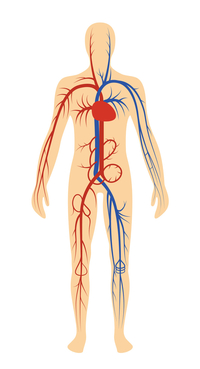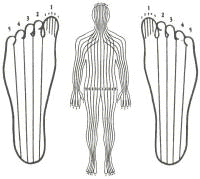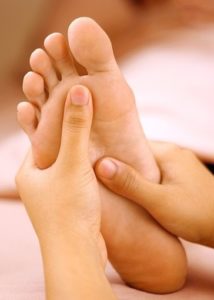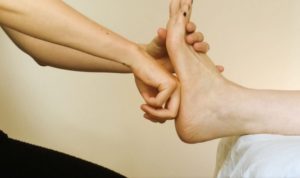Reflexology: also known as zone therapy, is an alternative medicine involving application of pressure to the feet and hands with specific thumb, finger, and hand techniques without the use of oil or lotion. It is believed that there are specific areas on the feet and hands that correspond with organs in the body. By stimulating certain areas, the circulation improves bringing blood and energy to those specific areas, thus relieving tension, pain and constrictions.
How does reflexology work?
Reflexologists postulate that reflexology helps release stress, which in turn helps the body heal and regenerate itself. There are several theories about how this process work.
Theory #1: Reflexology works with the central nervous system.
 This theory builds on research done in the 1890s by Sir Henry Head and Sir Charles Sherrington, who began to show through their research that a neurological relationship exists between the skin and the internal organs, and that the whole nervous system adjusts to a stimulus.
This theory builds on research done in the 1890s by Sir Henry Head and Sir Charles Sherrington, who began to show through their research that a neurological relationship exists between the skin and the internal organs, and that the whole nervous system adjusts to a stimulus.
According to the theory, the reflexologist’s application of pressure to feet, hands, or ears sends a calming message from the peripheral nerves in these extremities to the central nervous system, which in turn signals the body to adjust the tension level. This enhances overall relaxation, brings internal organs and their systems into a state of optimum functioning, and increases blood supply (which brings additional oxygen and nutrients to cells and enhances waste removal). It positively affects the circulatory,respiratory, endocrine, immune, and neuropeptide systems in the body.
Theory #2: Reflexology reduces pain by reducing stress and improving mood.
Another theory that may also explain how reflexology can produce pain relief is the gate control theory, or, more recently, the neuromatrix theory of pain. This theory suggests that subjective experiences, created by your brain cause pain. The brain does this in response to the sensory experience of pain. However, it can also work independently of sensory input and create pain in response to emotional or cognitive factors. Therefore things that influence the brain, such as your mood or external factors like stress can also affect your experience of pain. According to this theory, reflexology may reduce pain by reducing stress and improving mood.
Theory #3: Reflexology keeps the body’s “vital energy” flowing.
Yet another theory holds that there is a “vital energy” in the human body. Learn more about Qi (Chee) and other Chinese Medical concepts. This Qi must flow freely in balanced strength and quality. When the Qi is stuck or not flowing properly, there is an imbalance. This gives rise to disease. Energy blockages occur when there is a lack of smooth flow of Qi. Stress, when unaddressed, leads to congestion of energy. This in turn causes bodily inefficiencies, which can lead to illness. According to this theory, reflexology helps keep the energy flowing.
Theory #4: Zone theory
 The recognition of reflexology as a specific type of treatment began with Zone Theory, in which the body is divided into 10 vertical zones. Each zone corresponds to fingers and toes all the way up to the top of the head. For example, if you are standing up with your hands on your thighs (palms facing down) the thumbs and great toe would be zone 1. On either side of the body, the index finger and second toe would be zone 2, etc.
The recognition of reflexology as a specific type of treatment began with Zone Theory, in which the body is divided into 10 vertical zones. Each zone corresponds to fingers and toes all the way up to the top of the head. For example, if you are standing up with your hands on your thighs (palms facing down) the thumbs and great toe would be zone 1. On either side of the body, the index finger and second toe would be zone 2, etc.
In reflexology theory, It is possible to access every organ, valve, muscle, etc. that lies within a zone, via a point or area on the feet or hands. For example, working between toes 2 and 3, or fingers 2 and 3, the eye point is found. The nervous system connects these pathways between pressure points and other parts of the body.
Note: The zones are similar to, but not the same as meridians found in Chinese medicine. However, there are some correlations between meridians and location of organs on the feet and ankles.
To read more about Acupuncture and Chinese Medicine, go here.
The body is wise:
Reflexologists do not heal clients; the body repairs itself.


